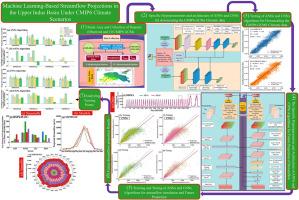Machine learning-based streamflow projections in the upper indus basin under CMIP6 climate scenarios
IF 4.1
3区 地球科学
Q2 GEOSCIENCES, MULTIDISCIPLINARY
引用次数: 0
Abstract
Pakistan's water security relies heavily on the Upper Indus basin (UIB), which provides nearly half of the country's surface water essential for agriculture, domestic use, and hydropower generation. Therefore, accurate future streamflow projections of this region are crucial for effective water resources management. This study used machine learning algorithms, artificial neural networks (ANNs) and convolutional neural networks (CNNs), to downscale ten Coupled model intercomparison project phase 6 Global Circulation Models (GCMs) climatic data at a regional scale. This research also developed ANNs and CNNs algorithms to project streamflow in the Upper Indus Basin (UIB) using downscaled climate data under SSP245 and SSP585 scenarios for the period of 2026–2055 and 2056–2085, validated against observed streamflow (1985–2015). The results indicated that ANNs and CNNs showed strong performance during testing and training for the downscaling of climatic data and based on (Coefficient of determination) R2 and (Kling–Gupta Efficiency) KGE values, five best performing downscaled GCMs (i.e., MIROC6, CNRM-CM6-1, CNRM-ESM2-1, CanESM5, IPSL-CM6A-LR) were selected for streamflow projection. For streamflow projection, CNNs model significantly outperformed than ANNs model during both training and testing phases, achieving mean squared error (0.0302) as the loss function and mean absolute error (0.0032) as the evaluation metric. Future streamflow projections, based on downscaled climatic data from five GCMs using the CNNs algorithm, showed an increasing behavior for the periods 2026–2055 and 2056–2085 compared to the 1985–2014 baseline, with a more intense increase projected under the SSP245 scenario than under SSP585. Among the five GCMs analyzed, CNRM-ESM2-1 projected the most intense increase in streamflow, with rises of 84 % and 97 % for the periods 2026–2055 and 2056–2085 under SSP245, and 59 % and 91 % under SSP585 respectively. This improved understanding of future streamflow will guide adaptive management for hydropower and water resources in UIB.

CMIP6气候情景下基于机器学习的印度河上游流域流量预测
巴基斯坦的水安全在很大程度上依赖于上印度河流域(UIB),该流域提供了该国近一半的地表水,这些地表水是农业、家庭用水和水力发电所必需的。因此,准确预测该地区未来的流量对有效的水资源管理至关重要。本研究利用机器学习算法、人工神经网络(ann)和卷积神经网络(cnn),在区域尺度上缩小了10个耦合模式比对项目第6阶段全球环流模式(GCMs)气候数据的规模。本研究还开发了ann和cnn算法,利用SSP245和SSP585情景下2026-2055年和2056-2085年的缩小尺度气候数据预测印度河上游流域(UIB)的流量,并根据1985-2015年的观测流量进行验证。结果表明,ann和cnn在气候数据降尺度的测试和训练中表现出较强的性能,并基于(决定系数)R2和(kelling - gupta效率)KGE值,选择了5个性能最佳的降尺度gcm(即MIROC6、CNRM-CM6-1、CNRM-ESM2-1、CanESM5、ipls - cm6a - lr)进行流量投影。对于水流投影,cnn模型在训练和测试阶段都明显优于ann模型,损失函数均方误差(0.0302)和评价指标均绝对误差(0.0032)均优于ann模型。利用cnn算法对5个gcm的缩小尺度气候数据进行的未来流量预估显示,与1985-2014年基线相比,2026-2055年和2056-2085年期间的流量呈增加趋势,且在SSP245情景下预估的流量增加幅度大于SSP585情景。在分析的5个gcm中,CNRM-ESM2-1预测的流量增长最为强烈,在SSP245条件下2026-2055和2056-2085期间分别增长了84%和97%,在SSP585条件下分别增长了59%和91%。这种对未来流量的更好理解将指导对亚投行水电和水资源的适应性管理。
本文章由计算机程序翻译,如有差异,请以英文原文为准。
求助全文
约1分钟内获得全文
求助全文
来源期刊

Physics and Chemistry of the Earth
地学-地球科学综合
CiteScore
5.40
自引率
2.70%
发文量
176
审稿时长
31.6 weeks
期刊介绍:
Physics and Chemistry of the Earth is an international interdisciplinary journal for the rapid publication of collections of refereed communications in separate thematic issues, either stemming from scientific meetings, or, especially compiled for the occasion. There is no restriction on the length of articles published in the journal. Physics and Chemistry of the Earth incorporates the separate Parts A, B and C which existed until the end of 2001.
Please note: the Editors are unable to consider submissions that are not invited or linked to a thematic issue. Please do not submit unsolicited papers.
The journal covers the following subject areas:
-Solid Earth and Geodesy:
(geology, geochemistry, tectonophysics, seismology, volcanology, palaeomagnetism and rock magnetism, electromagnetism and potential fields, marine and environmental geosciences as well as geodesy).
-Hydrology, Oceans and Atmosphere:
(hydrology and water resources research, engineering and management, oceanography and oceanic chemistry, shelf, sea, lake and river sciences, meteorology and atmospheric sciences incl. chemistry as well as climatology and glaciology).
-Solar-Terrestrial and Planetary Science:
(solar, heliospheric and solar-planetary sciences, geology, geophysics and atmospheric sciences of planets, satellites and small bodies as well as cosmochemistry and exobiology).
 求助内容:
求助内容: 应助结果提醒方式:
应助结果提醒方式:


